[English] 日本語
 Yorodumi
Yorodumi- PDB-3qlv: Crystal structure of the GluK2/GluK5 (GluR6/KA2) ATD tetramer assembly -
+ Open data
Open data
- Basic information
Basic information
| Entry | Database: PDB / ID: 3qlv | ||||||
|---|---|---|---|---|---|---|---|
| Title | Crystal structure of the GluK2/GluK5 (GluR6/KA2) ATD tetramer assembly | ||||||
 Components Components |
| ||||||
 Keywords Keywords | MEMBRANE PROTEIN / Glycosylation | ||||||
| Function / homology |  Function and homology information Function and homology informationregulation of synaptic vesicle fusion to presynaptic active zone membrane / protein retention in ER lumen / mossy fiber rosette / detection of cold stimulus involved in thermoception / Activation of Na-permeable kainate receptors / kainate selective glutamate receptor complex / Activation of Ca-permeable Kainate Receptor / regulation of short-term neuronal synaptic plasticity / glutamate receptor activity / ubiquitin conjugating enzyme binding ...regulation of synaptic vesicle fusion to presynaptic active zone membrane / protein retention in ER lumen / mossy fiber rosette / detection of cold stimulus involved in thermoception / Activation of Na-permeable kainate receptors / kainate selective glutamate receptor complex / Activation of Ca-permeable Kainate Receptor / regulation of short-term neuronal synaptic plasticity / glutamate receptor activity / ubiquitin conjugating enzyme binding / negative regulation of synaptic transmission, glutamatergic / regulation of JNK cascade / inhibitory postsynaptic potential / receptor clustering / kainate selective glutamate receptor activity / modulation of excitatory postsynaptic potential / extracellularly glutamate-gated ion channel activity / ionotropic glutamate receptor complex / positive regulation of synaptic transmission / behavioral fear response / neuronal action potential / glutamate-gated receptor activity / glutamate-gated calcium ion channel activity / ligand-gated monoatomic ion channel activity involved in regulation of presynaptic membrane potential / presynaptic modulation of chemical synaptic transmission / dendrite cytoplasm / hippocampal mossy fiber to CA3 synapse / SNARE binding / regulation of membrane potential / PDZ domain binding / transmitter-gated monoatomic ion channel activity involved in regulation of postsynaptic membrane potential / synaptic transmission, glutamatergic / excitatory postsynaptic potential / cellular response to glucose stimulus / establishment of localization in cell / regulation of long-term neuronal synaptic plasticity / postsynaptic density membrane / modulation of chemical synaptic transmission / SH3 domain binding / terminal bouton / intracellular calcium ion homeostasis / positive regulation of neuron apoptotic process / presynaptic membrane / neuron apoptotic process / scaffold protein binding / perikaryon / chemical synaptic transmission / negative regulation of neuron apoptotic process / postsynaptic membrane / postsynaptic density / axon / neuronal cell body / ubiquitin protein ligase binding / synapse / dendrite / glutamatergic synapse / endoplasmic reticulum / identical protein binding / membrane / plasma membrane Similarity search - Function | ||||||
| Biological species |  | ||||||
| Method |  X-RAY DIFFRACTION / X-RAY DIFFRACTION /  SYNCHROTRON / SYNCHROTRON /  MOLECULAR REPLACEMENT / Resolution: 3.94 Å MOLECULAR REPLACEMENT / Resolution: 3.94 Å | ||||||
 Authors Authors | Kumar, J. / Mayer, M.L. | ||||||
 Citation Citation |  Journal: Neuron / Year: 2011 Journal: Neuron / Year: 2011Title: Structure and assembly mechanism for heteromeric kainate receptors. Authors: Kumar, J. / Schuck, P. / Mayer, M.L. | ||||||
| History |
|
- Structure visualization
Structure visualization
| Structure viewer | Molecule:  Molmil Molmil Jmol/JSmol Jmol/JSmol |
|---|
- Downloads & links
Downloads & links
- Download
Download
| PDBx/mmCIF format |  3qlv.cif.gz 3qlv.cif.gz | 2 MB | Display |  PDBx/mmCIF format PDBx/mmCIF format |
|---|---|---|---|---|
| PDB format |  pdb3qlv.ent.gz pdb3qlv.ent.gz | 1.8 MB | Display |  PDB format PDB format |
| PDBx/mmJSON format |  3qlv.json.gz 3qlv.json.gz | Tree view |  PDBx/mmJSON format PDBx/mmJSON format | |
| Others |  Other downloads Other downloads |
-Validation report
| Summary document |  3qlv_validation.pdf.gz 3qlv_validation.pdf.gz | 531.4 KB | Display |  wwPDB validaton report wwPDB validaton report |
|---|---|---|---|---|
| Full document |  3qlv_full_validation.pdf.gz 3qlv_full_validation.pdf.gz | 607.2 KB | Display | |
| Data in XML |  3qlv_validation.xml.gz 3qlv_validation.xml.gz | 131.4 KB | Display | |
| Data in CIF |  3qlv_validation.cif.gz 3qlv_validation.cif.gz | 171.4 KB | Display | |
| Arichive directory |  https://data.pdbj.org/pub/pdb/validation_reports/ql/3qlv https://data.pdbj.org/pub/pdb/validation_reports/ql/3qlv ftp://data.pdbj.org/pub/pdb/validation_reports/ql/3qlv ftp://data.pdbj.org/pub/pdb/validation_reports/ql/3qlv | HTTPS FTP |
-Related structure data
| Related structure data |  3qltC  3qluC  3h6hS  3om0S C: citing same article ( S: Starting model for refinement |
|---|---|
| Similar structure data |
- Links
Links
- Assembly
Assembly
| Deposited unit | 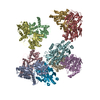
| ||||||||||||||||||||||||||||||||||||||||||||||||||||||||||||||||||
|---|---|---|---|---|---|---|---|---|---|---|---|---|---|---|---|---|---|---|---|---|---|---|---|---|---|---|---|---|---|---|---|---|---|---|---|---|---|---|---|---|---|---|---|---|---|---|---|---|---|---|---|---|---|---|---|---|---|---|---|---|---|---|---|---|---|---|---|
| 1 | 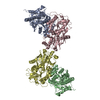
| ||||||||||||||||||||||||||||||||||||||||||||||||||||||||||||||||||
| 2 | 
| ||||||||||||||||||||||||||||||||||||||||||||||||||||||||||||||||||
| 3 | 
| ||||||||||||||||||||||||||||||||||||||||||||||||||||||||||||||||||
| 4 | 
| ||||||||||||||||||||||||||||||||||||||||||||||||||||||||||||||||||
| 5 | 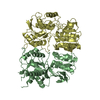
| ||||||||||||||||||||||||||||||||||||||||||||||||||||||||||||||||||
| 6 | 
| ||||||||||||||||||||||||||||||||||||||||||||||||||||||||||||||||||
| 7 | 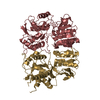
| ||||||||||||||||||||||||||||||||||||||||||||||||||||||||||||||||||
| 8 | 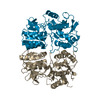
| ||||||||||||||||||||||||||||||||||||||||||||||||||||||||||||||||||
| Unit cell |
| ||||||||||||||||||||||||||||||||||||||||||||||||||||||||||||||||||
| Noncrystallographic symmetry (NCS) | NCS domain:
NCS domain segments:
|
 Movie
Movie Controller
Controller







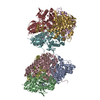
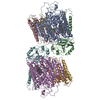
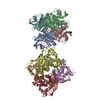

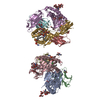
 PDBj
PDBj
